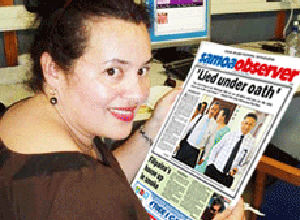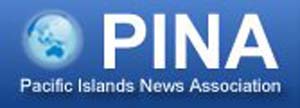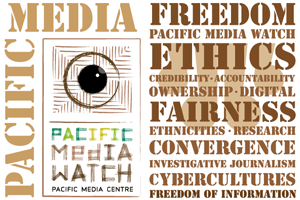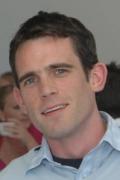
ANALYSIS: AUCKLAND: As many countries in the Asia-Pacific region suffer gags, murders, assaults and other pressures on press freedom, several Pacific groups have gathered in Samoa this week to mark World Press Freedom Day and strategise about better "regionalism".
From unofficial clampdowns on freedom of expression in Tonga, to recent violent attacks on media staff in Vanuatu and official laws silencing criticism of Fiji’s military-backed government, the Pacific is a growing minefield of media abuses.
Participating groups include network leaders from the AIDB Pacific Media Partnership, IFJ Pacific Media Human Rights and Democracy Project, Pacific Alliance for Development Journalists, Pacific Freedom Forum, Pacific Islands Media Association, Pacific WAVE Media Network and PasiMA.
However, the region's major media network, the Suva-based Pacific Islands News Association (PINA) - which claims to represent 23 media organisations around the region and has a foundation policy of "defending freedom of expression and information" - is not present.
Nor are the region's three main Pacific journalism schools, Divine Word University (Madang, Papua New Guinea), University of the South Pacific (Fiji) and New Zealand-based AUT University's Pacific Media Centre, which all run media freedom programmes.
The UNESCO Pacific-funded dialogue, organised by regional coordinator for the IFJ Pacific media project, Lisa Williams-Lahari, was originally scheduled to be held in Suva, Fiji. But after the location was changed three times it is now being hosted by the National University of Samoa (NUS) in Apia, Samoa.
Commentators in the Pacific as well as in New Zealand say freedom of the press in a democratic country like New Zealand can just as easily be eroded by the "more insidious disease of self-censorship".
Media in democratic countries can be swift to turn a blind eye to whole interest groups, losing that fairness, balance and accuracy widely regarded as the hallmark of good news organisations.
Media freedom organisations have been increasing in the Pacific and here is a checklist of some leading groups:
 PINA (Pacific Islands News Association): Founded in 1972, this Suva-based organisation has long been regarded as the major media body of the Pacific. While critics argue this is no longer the case, PINA remains the major player in town. Moses Stevens, current president of PINA, writes for the Vanuatu Times. PINA owns a regional news agency PACNEWS, which came under PINA’s control after the 2004 merger of PINA and the now-defunct Pacific Islands Broadcasting Association (PIBA).
PINA (Pacific Islands News Association): Founded in 1972, this Suva-based organisation has long been regarded as the major media body of the Pacific. While critics argue this is no longer the case, PINA remains the major player in town. Moses Stevens, current president of PINA, writes for the Vanuatu Times. PINA owns a regional news agency PACNEWS, which came under PINA’s control after the 2004 merger of PINA and the now-defunct Pacific Islands Broadcasting Association (PIBA).
It is the best-funded of any of the Pacific media groups and donors include AusAID.
PINA has been criticised for "kowtowing" to the Fiji regime in recent years and high-profile members have since resigned - such as John Woods, former vice-president and editor of Cook Islands News. Stevens believes he is steering PINA in a different direction than some would like, but PINA is "staying faithful" to its founding mission of educating Fijian and Pacific societies about the media, in spite of being under the shadow of a military-backed government.
Supporters see the recent opening of a PINA office in Port Moresby, PNG, as evidence of the aim to educate further afield than Fiji.
Stevens is a member of the Media Association of Vanuatu (MAV), currently led by Evelyn Toa as president. MAV has had a long-running feud with the publisher of the Vanuatu Daily Post, Marc Neil-Jones, on issues over reporting balance and media freedom in Vanuatu.
Publishes: PACNEWS
Other groups include:
FMW: Fiji Media Watch is another body in Fiji and is focused on education of young people and media advocacy. FMW began in 1993 and aims to promote media literacy by raising awareness of the power of the mass media in a country such asFiji. FMW regularly holds media seminars and has recently earned the ire of mainstream media outlets for criticisms of mainstream media.
IFJ (International Federation of Journalists): The Brussels-based global journalists organisation runs its Asia-Pacific office out of Sydney in its Australian-affiliated Media, Entertainment and Arts Alliance. It launched the European Union funded Pacific Media Human Rights and Democracy Project last year and has been running workshops on monitoring media freedom strategies and researching media freedom. Asia-Pacific director is Jacqui Park and the regional Pacific project coordinator is Lisa Williams-Lahari of the Cook Islands. The IFJ is currently researching media freedom problems in the Pacific and aims to publish a report later in the year.
Publishes: Asia-Pacific news portal
NIUSbeatPacific Newsletter
 PFF (Pacific Freedom Forum): This group was founded in 2008 and is registered in the Cook Islands. It has interim co-chairs, Susuve Laumaea, who writes for the Sunday Chronicle in PNG and former PINA president Monica Miller from KHJ Radio in American Samoa. Founding coordinator is Lisa Williams-Lahari. Funders for PFF projects have included UNESCO Pacific and the IFJ Pacfic project. The organisation operates a successful online Pacific Islands Journalists Online network (PIJO) and posts regular alerts. It recently came to the defence of Marc Neil-Jones, publisher of the Vanuatu Daily Post, who was brutally attacked in his office this year - allegedly by government minister Harry Iauko.
PFF (Pacific Freedom Forum): This group was founded in 2008 and is registered in the Cook Islands. It has interim co-chairs, Susuve Laumaea, who writes for the Sunday Chronicle in PNG and former PINA president Monica Miller from KHJ Radio in American Samoa. Founding coordinator is Lisa Williams-Lahari. Funders for PFF projects have included UNESCO Pacific and the IFJ Pacfic project. The organisation operates a successful online Pacific Islands Journalists Online network (PIJO) and posts regular alerts. It recently came to the defence of Marc Neil-Jones, publisher of the Vanuatu Daily Post, who was brutally attacked in his office this year - allegedly by government minister Harry Iauko.
Publishes: PFF blog
PIMA (Pacific Islands Media Association): This is an Auckland-based media body that takes most of its membership from Pasifika people working in media in New Zealand. Iulia Leilua of Māori Television is current president and was a founding member of the association. Other members of the executive include deputy chair Chris Lakatani and secretary Sandra Kailahi of TVNZ.
PIMA holds a yearly conference, in conjunction with AUT University, and supports Pasifika students that wish to study communications and journalism at tertiary level with scholarships. Several Pasifika media personnel in recent years have emerged from AUT’s journalism programme.
Publishes: PIMA blog
 PMW (Pacific Media Watch): Founded in 1996 by a network of independent journalists led by David Robie at the University of Papua New Guinea and Peter Cronau, then of the University of Technology, Sydney, and now with the ABC's Four Corners investigative team. This group is now run by the Pacific Media Centre at AUT University in Auckland. The project is partially funded by a Pacific Development and Conservation Trust grant and holds extensive media, video and document archives, many of them on a DSpace public database. Contributing editor is Alex Perrottet. PMC is a regional media and publications centre and publishes news, books and Pacific Journalism Review. It is also a base for postgraduate Asia-Pacific media students and runs international media projects with industry partners. Current chair of the industry/university advisory body is John Utanga of TVNZ's Tagata Pasifika programme.
PMW (Pacific Media Watch): Founded in 1996 by a network of independent journalists led by David Robie at the University of Papua New Guinea and Peter Cronau, then of the University of Technology, Sydney, and now with the ABC's Four Corners investigative team. This group is now run by the Pacific Media Centre at AUT University in Auckland. The project is partially funded by a Pacific Development and Conservation Trust grant and holds extensive media, video and document archives, many of them on a DSpace public database. Contributing editor is Alex Perrottet. PMC is a regional media and publications centre and publishes news, books and Pacific Journalism Review. It is also a base for postgraduate Asia-Pacific media students and runs international media projects with industry partners. Current chair of the industry/university advisory body is John Utanga of TVNZ's Tagata Pasifika programme.
Publishes: Pacific Scoop
PMC Online media website
 PasiMA (Pasifika Media Association): This group is the youngest of the media freedom bodies to rise out of the islands. With notable figures such as president Savea Sano Malifa, editor-in-chief of the Samoa Observer, as well as Kalafi Moala, chief executive of Tonga’s Taimi Media Network, PasiMA emerged mainly through members’ dissatisfaction with PINA. On its website, PasiMA describes itself as the "professional association of Pasifika’s regional independent media owners, operators and principals".
PasiMA (Pasifika Media Association): This group is the youngest of the media freedom bodies to rise out of the islands. With notable figures such as president Savea Sano Malifa, editor-in-chief of the Samoa Observer, as well as Kalafi Moala, chief executive of Tonga’s Taimi Media Network, PasiMA emerged mainly through members’ dissatisfaction with PINA. On its website, PasiMA describes itself as the "professional association of Pasifika’s regional independent media owners, operators and principals".
Its formation last year followed the resignation of several members, who have splintered off to other bodies such as PFF over the years. Moala argued last year that the time was right for a new media body and said it was not only the failure of PINA that gave birth to the new group, but a need to further educate the public about media issues. The Samoa-based group received a funding grant from the US Embassy to develop its website, produced by the Pasifika Foundation in Hawai'i.
“The story in the Pacific is that governments have always been the culprit in terms of media freedom,” said Moala, a former president of PIMA in NZ. He said Pasima meant "concrete fortress" in both Samoan and Tongan and vowed that the organisation would be just that when safeguarding the right to free speech.
Publishes: PasiMA blog
RSF (Reporters Sans Frontières): This Paris-based global media freedom body is also known as Reporters Without Borders, and monitors the Pacific under its "Asia" chapter. It has a network of Pacific journalists around the region and also in Australia and NZ, and has kept a close eye on "war on terror" legislation in both countries. It provides an annual index on censorship and has begun listing a growing number of Pacific countries.
Publishes: RSF Online and many media freedom books.
Media gather to mark World Press Freedom Day
Savea accuses PINA of losing 'critical voice' in media freedom message



